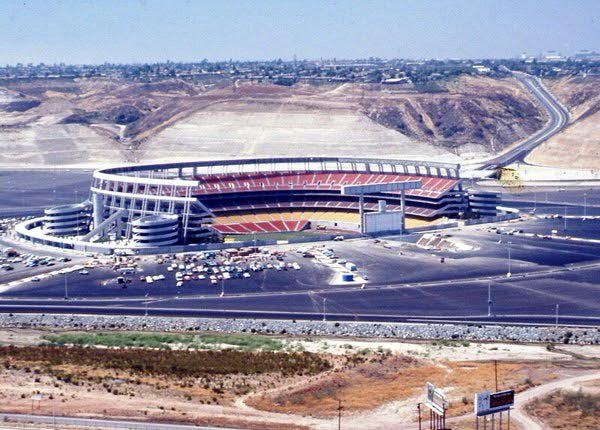Why the Mission Valley Stadium Site is So Tricky

Lost is all the discussion of the Mission Valley Stadium site is the question of what to do with the stadium?
The Soccer City plan includes a new 36,000 seat soccer stadium. SDSU is announcing plans for a slightly larger stadium about the same size.
Both plans will require that the current stadium be demolished
AGED AND OUTDATED?
The impression that the stadium is old and obsolete at 50 years of age, and on the surface seems to be true.
There is also a Charger’s hangover in which many former fans would like to see any remnant of the Bolts tenure here just disappear. SDSU seems enamored by the idea of a new stadium that they believe will best meet their needs and assist in their recruiting efforts.
The old stadium should just be made to go away. The City agrees.
RETROFIT, A SMARTER PATH?
Reuse of the stadium has been discussed but mostly as an NFL type redesign.
The latest attempt at this idea came last March when HKS, the architect designing the new Inglewood Rams stadium, did an analysis of the feasibility of a huge stadium addition and provided concept drawings of an NFL style stadium overwhelming the old stadium.
Their conclusion was that the stadium could support such a plan and verifies that the stadium has the structural integrity to support it (or a downsizing). In fact, from a structural perspective the stadium is actually on the young side , according to David Marshall an historic building architect with Heritage Architects in San Diego (they designed the adaptive reuse of the Western Metals building that is part of PetCo Park).
OPEN EAST END FROM 1967

The stadium was completed and opened in 1967.
From an historical perspective, the stadium is one of only two San Diego projects to have won a National AIA (American Institute of Architects) award.
The stadium is iconic and iconic is in short supply here.
It is currently on a list of sites to be considered for an historic designation which would be triggered once a permit was applied to remove the stadium. This would also set into motion CEQA (California Environmental Quality Act) compliance.
ISSUES WITH THE LOCATION
The site is particularly problematic because it is mostly within the San Diego River flood plain which comprises of alluvial type soil that is unstable and prone to liquefaction during seismic events.
What is required for construction on this type of soil is above standard and costly footings. The stadium footing design requires that steel beams be driven down to bedrock (130 feet) under and around the perimeter of the stadium foot print. This means that the stadium is actually resting on bedrock.
If replaced today, it would cost around $500 million. Marshall estimates the stadium has at least another fifty years of economic life. Mississippi State and University of Wisconsin stadiums that are similar in design are more than 100 years old.
FISCAL IMPLICATIONS OF DEMOLISHING
The economic ramifications of removing the stadium and the time required to achieve the permits necessary to commence a demolition are not generally understood or are being ignored.
The approval of a ballot measure would make the permitting process easier with the city but it would not provide any relief from Federal and State agencies like the Army Corps of Engineers and California Fish and Wildlife that are both thick bureaucracies that have jurisdictions over rivers and floodplains.
The costs associated with the permitting and demolition are estimated by Jack Carpenter, former President of the local AIA, to total around $60 million.
Even more impactful, the time necessary to complete the permit process could take four years (add ten months for the actual demolition; Candlestick Park took ten months to remove). Carpenter uses the South Bay Power plant as an example. It was much smaller than the stadium and required ten years to permit its demolition.
The Port of San Diego paid the demolition costs of $20 million that did not include any of the processing or legal costs that are estimated to have been more than double the actual demolition cost. That structure was imploded which is less expensive than breaking it apart and hauling it away, as would be necessary for the stadium.
It won’t be possible to regrade the concrete onto the floodplain, so it would have to be hauled away one truck load at a time.
Consider that in today’s Mission Valley traffic.
RECYCLE THE STADIUM
Both Carpenter and Marshall believe the most important consideration for “recycling” the stadium is environmental and from that perspective the most responsible approach would be to modify and reuse it, they say.
The stadium is structurally worthy to support a redesign, it's historic, it's iconic and preserving it has merit, and it would be environmentally responsible to do so.
So, what is the vision of a redesigned stadium?
GO BACK TO THE ORIGINAL CONFIGURATION
Marshall, Carpenter and Frank Hope (his firm designed it originally) recommend the stadium be returned to its original configuration of 48,000 seats with the east end of the stadium being re-opened to see the mountains again and let the air flow.
This is an ideal college football and NFL stadium size. The NFL is now considering smaller stadiums. It appears the league wants a made for television and virtual reality backdrop of full seats.
The final point to be made about reusing the stadium is that it is going to be more cost effective to modify the current stadium as outlined than to build a new one. This is further impacted when you consider the costs and time necessary to remove the structure. Whatever advantages are perceived in the building of a new stadium, will not offset the economic advantage of keeping and retrofitting the current facility.
So, while were thinking about it, let’s try a stadium name on for size: Don Coryell Aztec Stadium.





